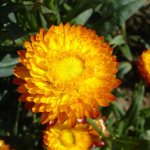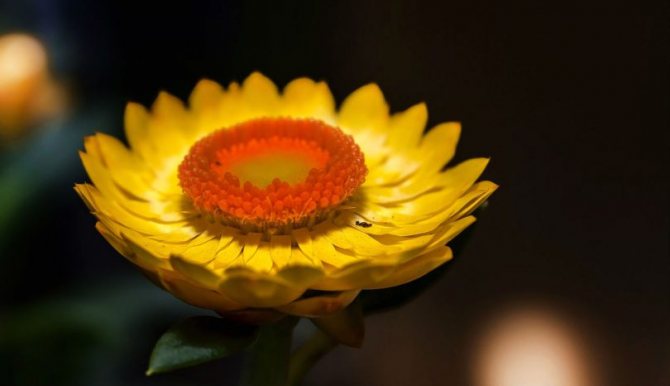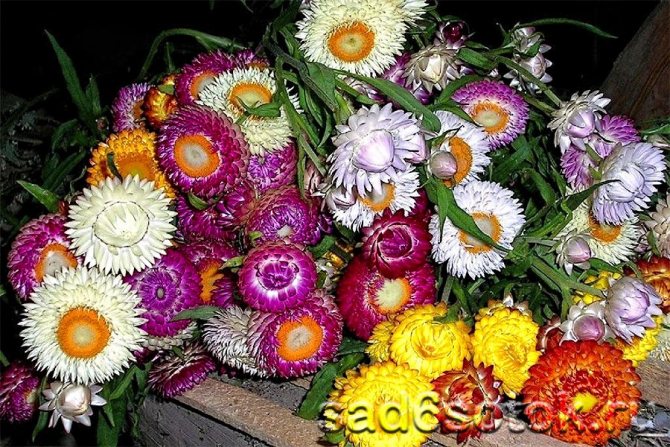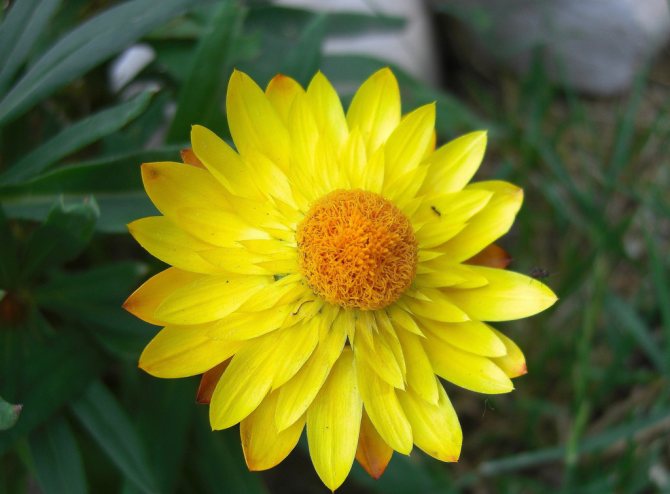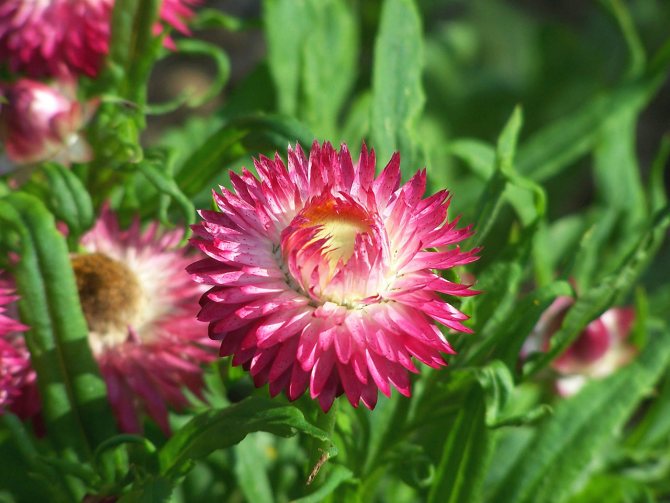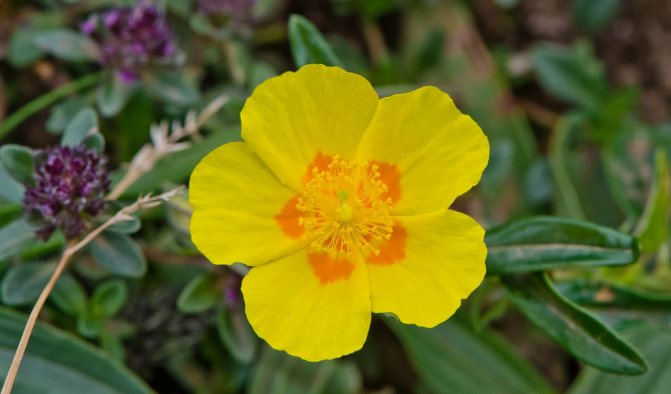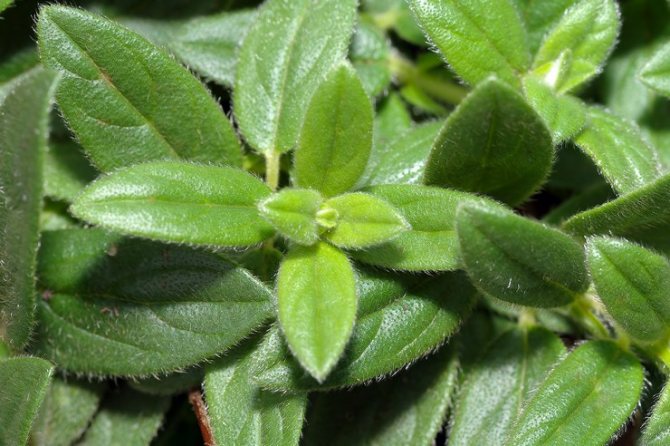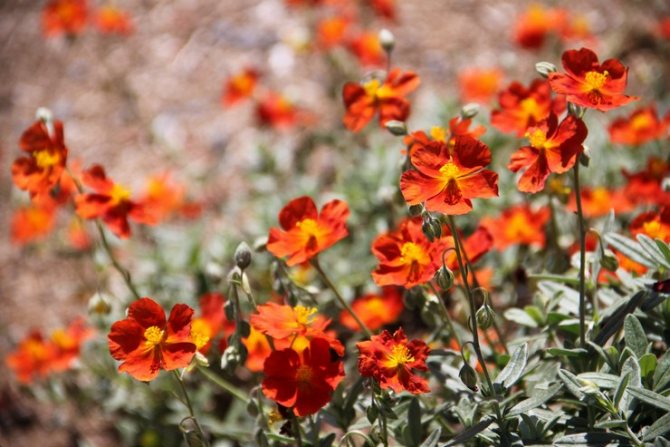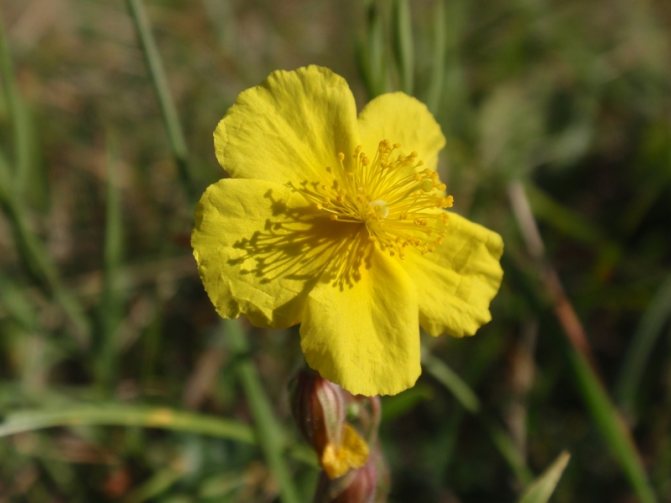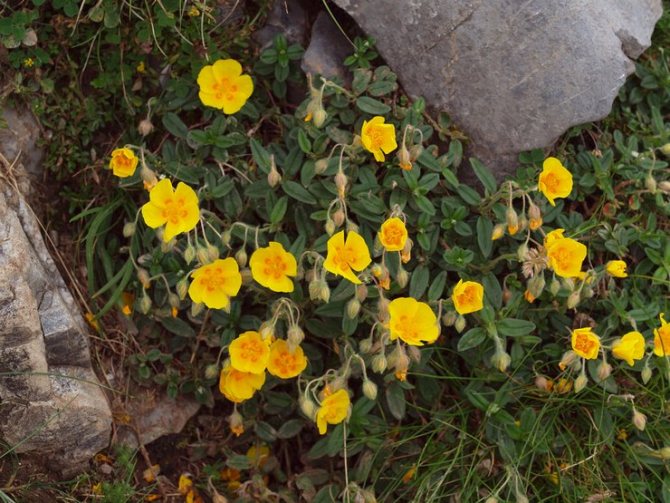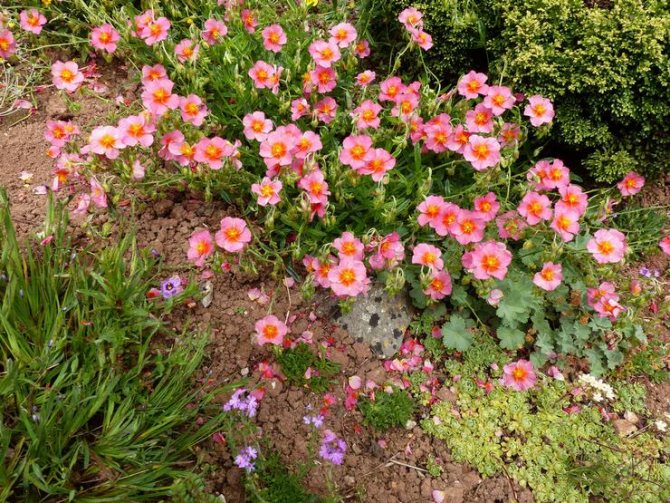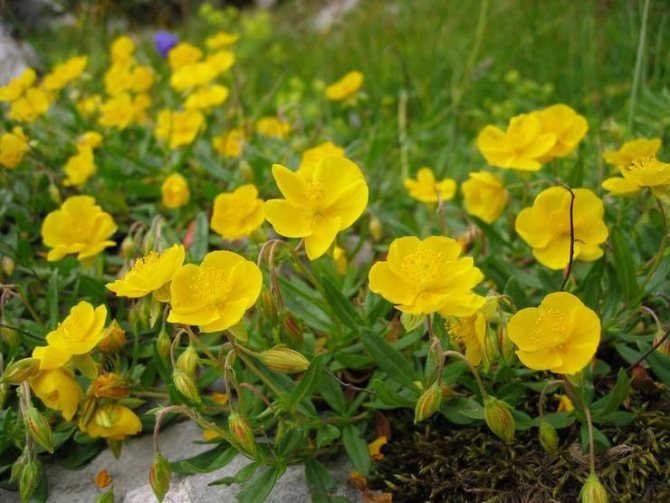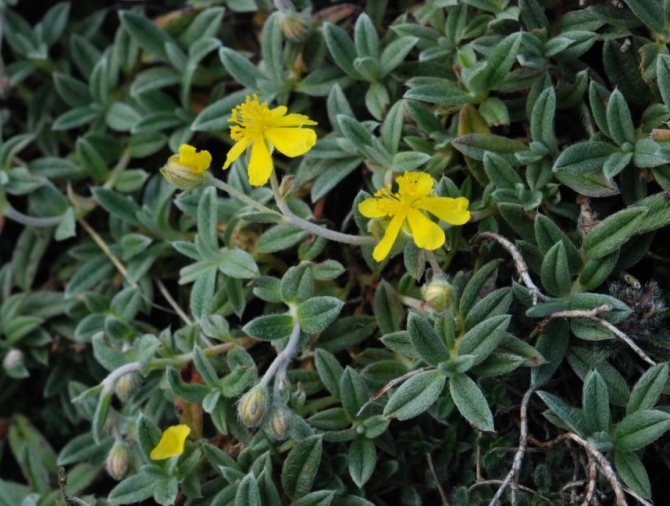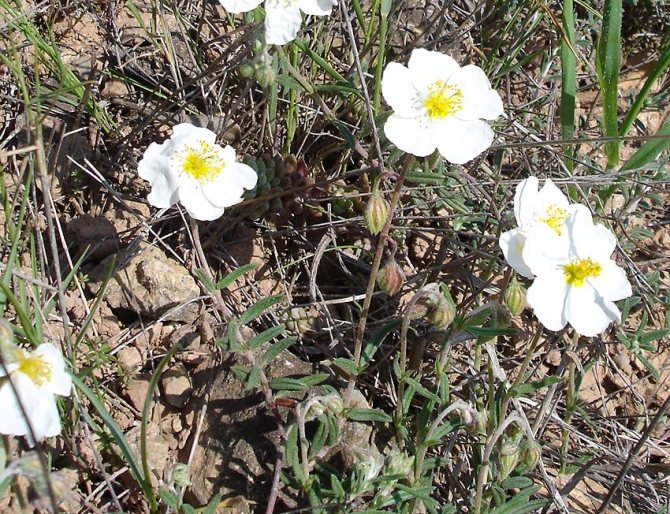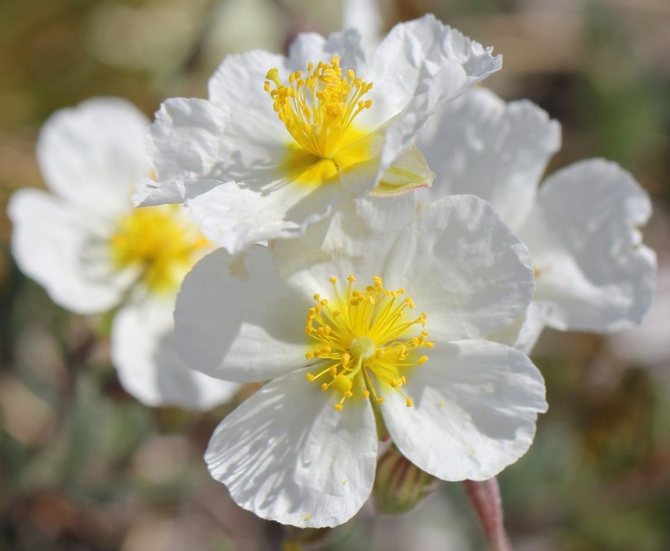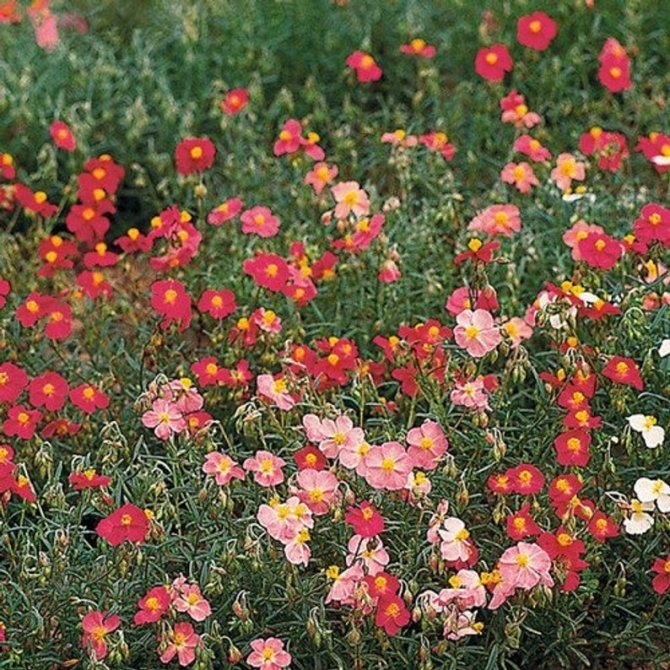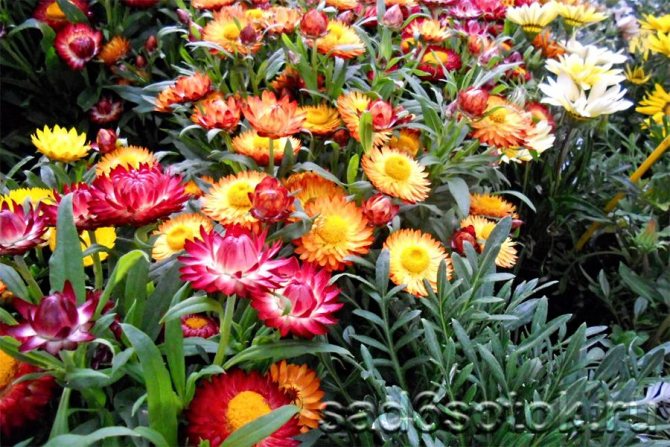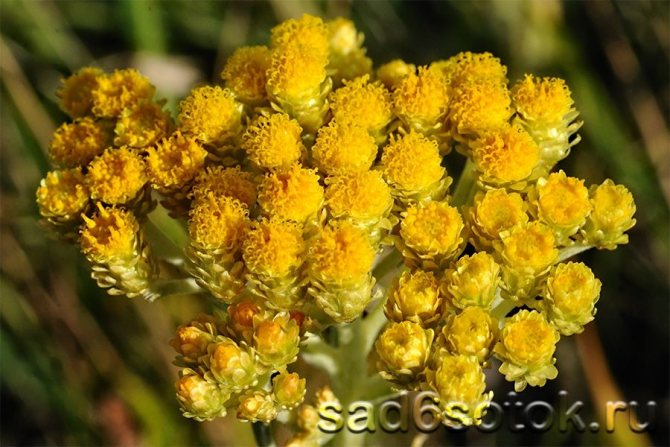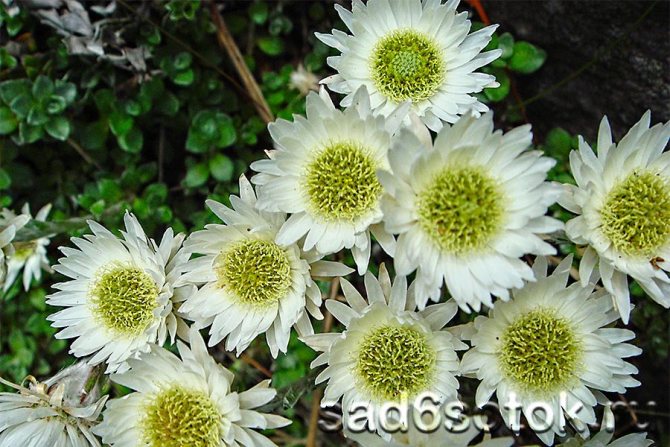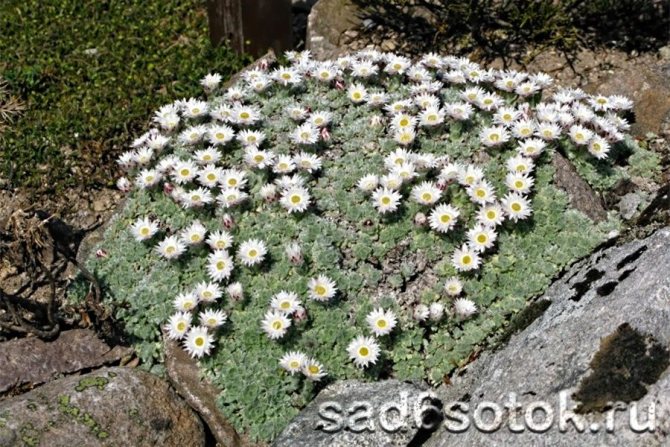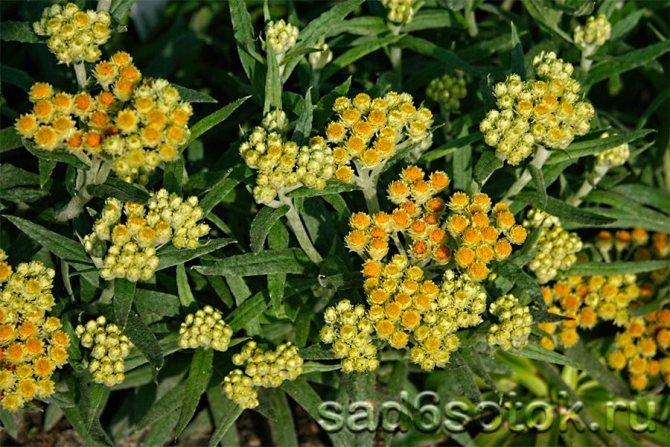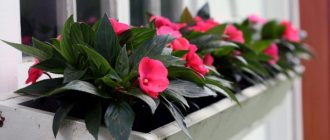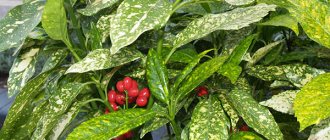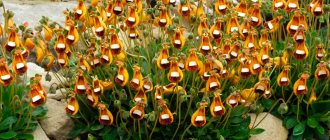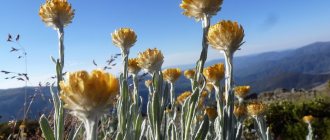needs regular watering, likes moist soils
does not bloom in central Russia
leaves are alternate, dense, cordate, rounded at the ends, on short petioles, pubescent, gray-green
- in container compositions as a filler and background for other plants;
- as a ground cover plant
evergreen shrub grown as an annual herb
Nobody has created threads yet
Still not cutting petunias? In vain, you know! They will only be more beautiful from this. Indeed, over time, petunias, whether they are spray, am.
This festival is always a riot of bright colors, dozens of designer gardens and unique flower arrangements. Over 30,000.
Gelikhrizum belongs to the Asteraceae family. In Greece, the flower is called the "Golden Sun" due to the shape of the flowers and their color. Popularly, this plant can be found under the name Tsmin, immortelle and cat's paws. Its homeland is Australia and the African continent, where there are more than five hundred plant species, thirty of which are used as horticultural crops. Some varieties of immortelle are similar in appearance to grass, while others grow in the form of a bush.
Since cmin is easily adaptable to different climates, it can also be found in our country. It has gained wide popularity due to its beauty, long flowering period and versatility. Gelichrizum is used in landscape design and floristry, combining it with other flowers.
Description of the plant
The genus of the immortelle includes not only perennials, but also annuals. There are also creeping and erect, shrubs and semi-shrubs.
Tsmin has a branched, fibrous root. The stem, depending on the species, can be ribbed, erect, creeping, the height of which is within 8 - 120 cm.The leaves are narrow, lanceolate, 3-7 cm long.Their color varies depending on the species: they can be dark green, yellow or bluish.
The gelichrizum flower has the shape of a basket or panicle with dry petals. The diameter of the inflorescence does not exceed 7 cm. The shade can be different, both white and pink, crimson, red, yellow. The immortelle cannot be blue. After flowering, a seed box is formed.
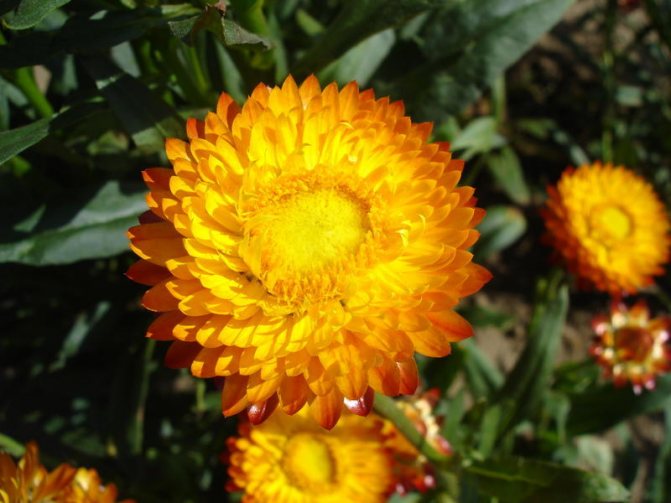
Sunflower care in the garden
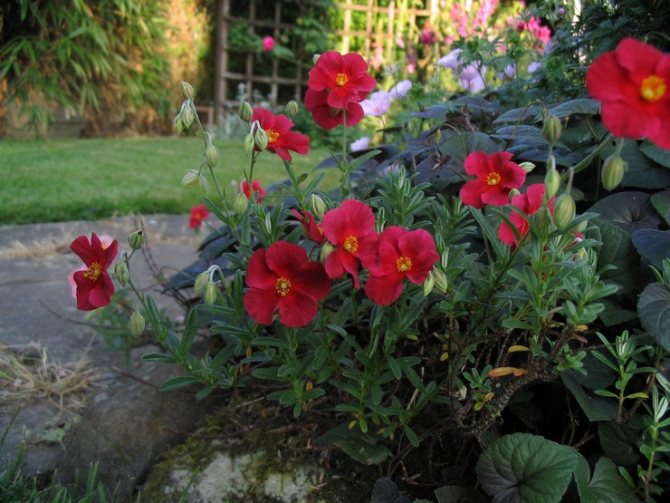

Watering
Sunflower is endowed with high resistance to droughts, so it usually has enough natural precipitation with their regular fall. It is not recommended to water the flowers during the spring and autumn months. In the summer, the soil is moistened only with a long absence of rain and high air temperatures for a long time. Irrigation water is preliminarily settled and heated in an open sunny area. Summer watering is plentiful.
The soil
The soil must be weeded and loosened in a timely manner around each plant. The mulching layer on the site will relieve you of these procedures and give additional nutrition to the soil.
Fertilization
When growing a sunflower on fertile soil, it will not need any additional feeding. In other cases, fertilizers are used as needed. Before flowering, it is recommended to feed the plants with liquid organic matter.It is important to remember that excess nutrients in the soil will lead to an abundant build-up of leaf mass, which will interfere with active flowering.
Pruning
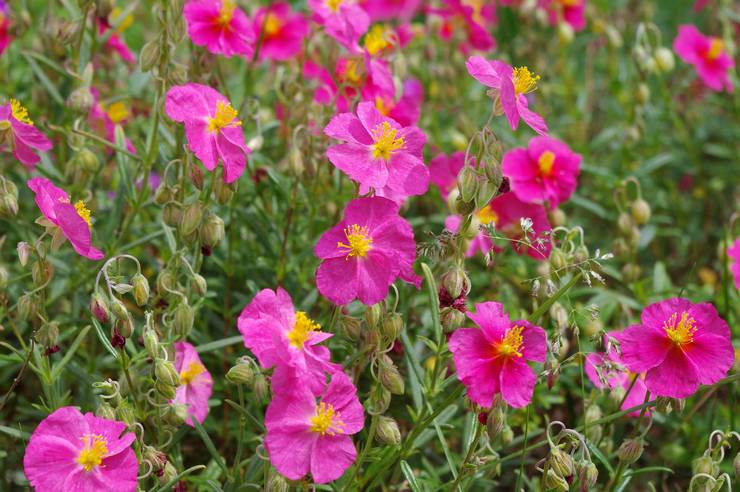

To maintain the attractiveness and preserve the high decorativeness of the sunflower, withered and faded buds are regularly trimmed. Removal of faded shoots (about 30% of the total length) will promote more active and lush flowering.
Wintering
Some species and varieties of plants are very cold resistant and do not require any preparation for winter. This applies to the sunflower with orange and yellow flowers. Over the course of several years, the culture is developing and growing well in one area. But cultures with silvery leaves and varieties with red flowers are recommended to be covered with dry grass or spruce branches, otherwise they will not survive the harsh cold.
Types and varieties of cmin
In Australia and Africa, there are real species of immortelle, which include more than 500 varieties. In Russia, about 30 species of gelichrizum are actively grown, photos and descriptions are presented in the table.
| Variety name | Description |
| Gelichrizum Bracts | This is a perennial herbaceous tall cmin. The plant has a straight, branched stem, reaching a height of 0.8 m. Leaves are sessile, dark green in color. The flowers are tubular, surrounded by white, orange, red bracts. Collected in basket-shaped inflorescences. The flowering period is from July to October. |
| Gelikhrizum Selago | This is an annual creeping immortelle. Leaves are small in size, dark green, collected in whorls. They cover the stem densely. At the ends of the stems, inflorescences are formed, collected in baskets. Flowers are white or light yellow. |
| Gelikhrizum Pereshkovy | Photography, planting and grooming are demonstrated in many landscape design tutorials. This species is especially appreciated for the decorativeness of its leaves. The stems reach a height of 1 m. Rounded or oval leaves are collected in rosettes and cover the shoots with a dense ring. Usually colored bright green, bluish or yellow. In the northern regions, the immortelle does not bloom, but in the southern regions, small gray-yellow flowers appear on it. It is recommended to grow in hanging flowerpots, and bring in a warm place for the winter. |
| Helichrizum Coral | It is a perennial plant species. Not afraid of severe frosts. It has branched stems, reaching a height of 25 cm. The leaves are small, drooping, have a scaly shape. Flowers do not attract attention, mostly yellow and white. |
| Gelikhrizum Narrow-leaved | It is a bush, reaching a height of 25-30 cm. The leaves are narrow, silvery. Used for border decoration. |
| Gelikhrizum Terry | One of the most popular species, reaches a height of 1 m. On each bush, up to 25 inflorescences can form, the diameter of which does not exceed 7 cm. Flowers are predominantly white, yellow, orange, red and pink. Used for disembarkation in clubs and for the formation of bouquets. |
| Gelikhrizum Sandy | It is a perennial plant species. Blooms from July to October. It does not exceed 10 cm in height. Flowers are small with a characteristic yellow tint. |
| Gelichrizum Milford | It is a perennial plant. Tsmin has a miniature size. Flowering period May-July. During flowering, a low, profusely blooming carpet is formed. The flowers of gelichrizum are white on the inside and pink on the outside. |
| Gelichrizum Daisy | It is a perennial ground cover plant. The immortelle does not exceed 8 cm in height. This type of cmin can grow up to 0.5 m. Leaves are small in size, steel shade. |
Each type of gelichrizum develops well in hot weather and lack of moisture.
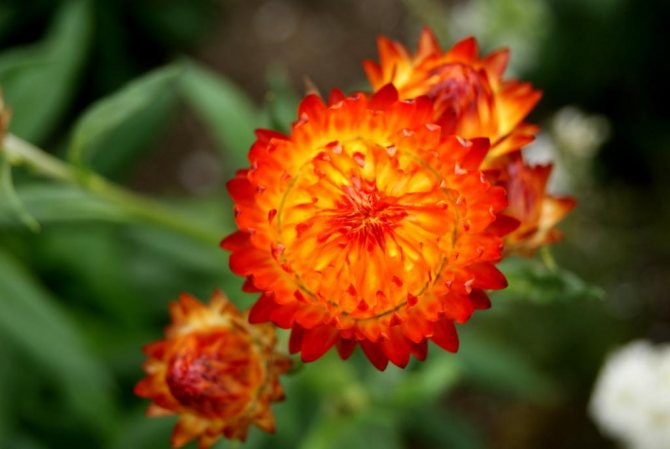

Petiolate immortelle (Helichrysum petiolare)
An evergreen perennial cushion-shaped subshrub that is grown as an annual. He is originally from South Africa.
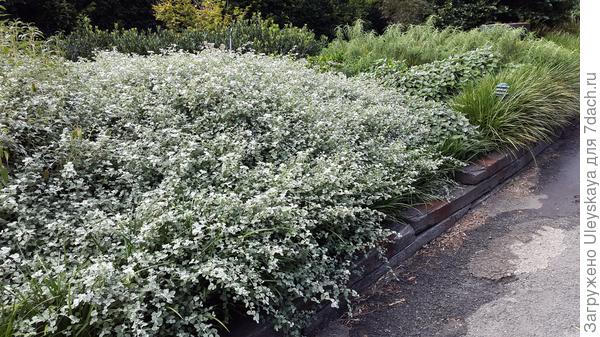

Petiolate immortelle. Photo from the site .au It is up to 50 cm high and up to 2 m wide. The leaves are cordate, small, 3.5 cm long, silvery-gray, densely pubescent. The capitate inflorescences of cream flowers are inconspicuous.
- 'Aurea', syn. ‘Limelight’ - pale green leaves, lime;
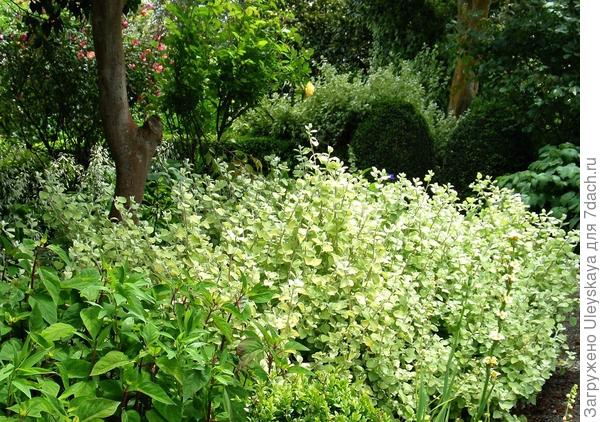

Petiolate immortelle 'Limelight'. Photo from the site
- ‘Roundabout’ - miniature, 15 cm high and 30 cm wide; descended from 'Variegatum', therefore often produces variegated shoots;
- ‘Variegatum’ - leaves are gray, with a creamy irregular border.
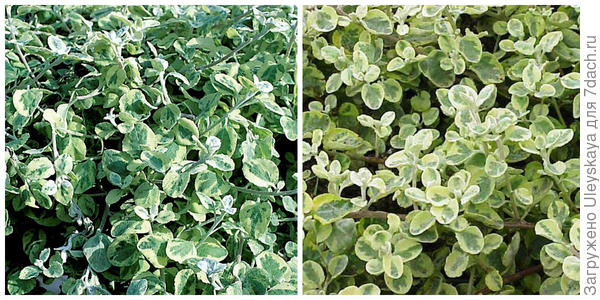

'Roundabout' petiole immortelle. Photo from the site blabus.pl. Petiolate immortelle 'Variegatum'. Photo from the site It grows both in the sun and in the shade. Requires well-drained soil; tolerates dry conditions, but can die in very wet areas. In Russia, its seeds can be found on sale marked "supernova from Italy." It is good in company with other drought-resistant species: lavender, catnip, monarda, and so on. It tolerates pruning well: it can be shaped in a semicircle, but the compact shape can only be maintained with garden shears.
Reproduction of the immortelle
Annual plants are grown using seeds. Perennial cmin is propagated by cuttings and dividing the bush.
In order to properly collect the seeds, it is necessary to leave the inflorescences until the seeds are fully ripe (this process begins at the end of September). You can collect seed in half a month after the flower has completely wilted. After that, the seeds are collected and folded into a paper (tissue) bag. Store in a cool dry place for no more than 2 years.
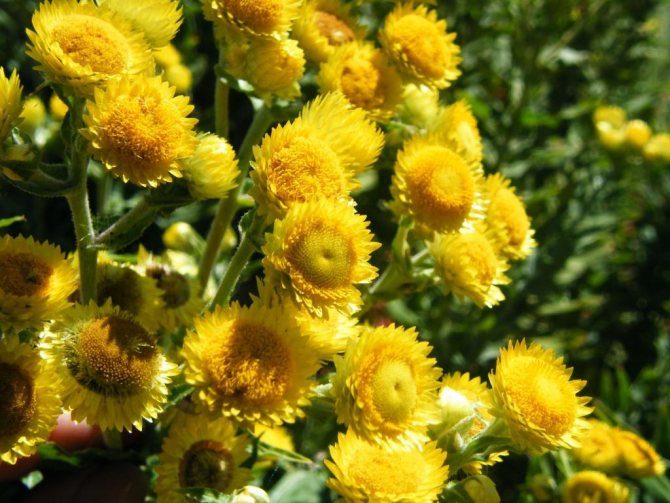

When to plant
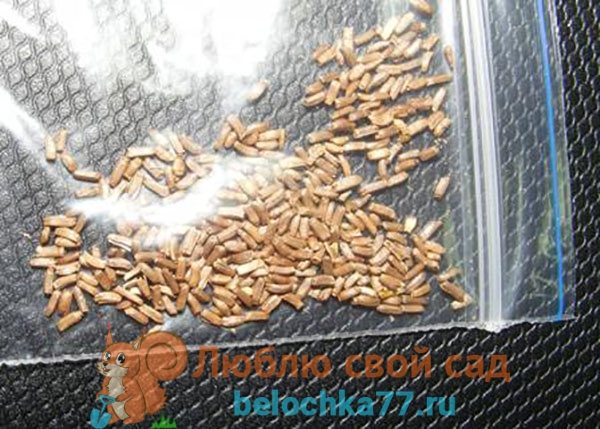

Seeds, mainly of tall varieties for seedlings, are sown in March. Sowing seeds in open ground is carried out in April. Most often, undersized varieties are grown in the open field.
Cuttings of flowers are planted in August - September or in spring, after wintering indoors. Divided bushes are planted in the spring.
How to plant?
Photos and descriptions of gelichrizum can be found in many book publications. Some types of cmin are grown using seeds. They begin to sow seedlings at the end of April.
For sowing seeds, a sand-peat mixture is used. It is placed in a container or box with drainage holes. Before sowing seeds, the soil is watered with a hot solution of potassium permanganate. After a while, the seeds are buried in the soil by 0.5-1 cm. You should very carefully monitor the moisture content of the soil. If it dries up, then it must be sprayed with a spray bottle. The soil should always be moist, but not too wet.
After the appearance of the first 2 leaves, and this happens 9-12 days after planting the seed, they are dived into a large box. The distance between the shoots should not be less than 5 cm. The flower tolerates transplantation well. Therefore, they are planted in a permanent place at the end of May.
Some types of gelichrizum can be sown in May directly into open ground. However, in this case, flowering may occur later. For this, holes are prepared in advance at a distance of 0.1 m from each other. And seeds are sown in them, 3-4 pieces per hole. Crops are covered with foil. And they remove it after the soil warms up to +15 degrees.
If the seeds were bought in specialized stores, then a photo of helihrizum flowers can be seen on the package.
Popular varieties
Some of the more popular varieties include:
Pink porcelain
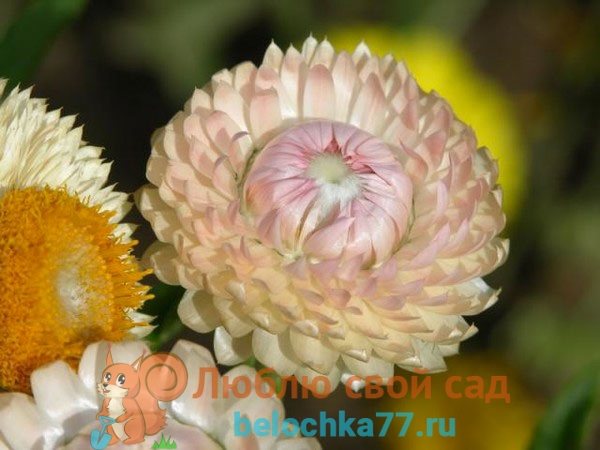

Grade Pink Porcelain
It reaches a height of 20 centimeters. The diameter of the bud is 3 centimeters. The color is pale pink. The variety is resistant to weather conditions.Flowering lasts until October.
Chico Red dwarf
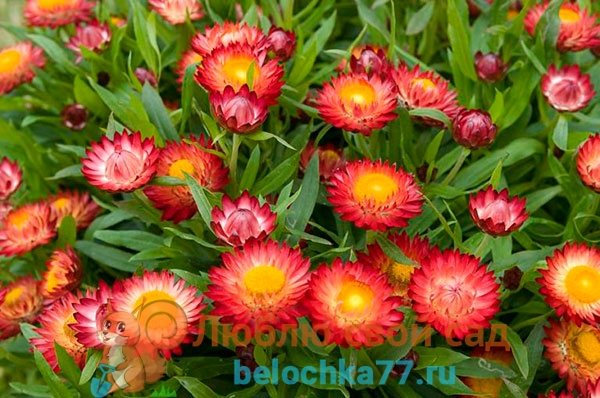

Chico Red dwarf variety
A small annual bush, 40 centimeters high. The foliage is dark green. Inflorescences-baskets are bright red and burgundy. Their middle is yellow. The petals are slightly curved. Flowering lasts from May to September. The plant looks beautiful in small baskets, small pots and as living borders.
Fayerbal
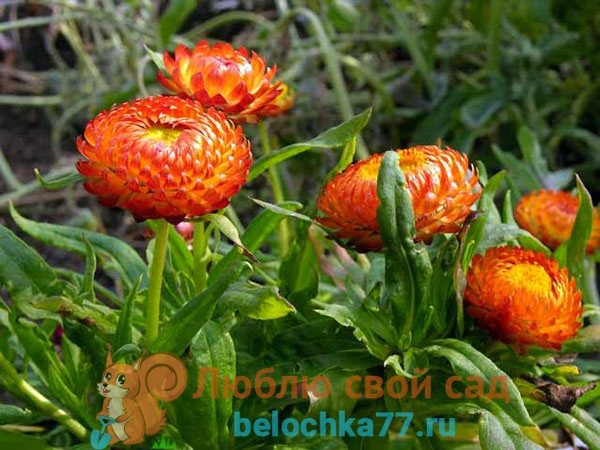

Fayerbal variety
The bush is 115 centimeters high. Stems are erect. Leaves are linear. Flowering period July - August. The inflorescences are convex in diameter, 5-6 centimeters, surrounded by a multi-row wrapper. Scales are scarious, brownish-red.
Lotus
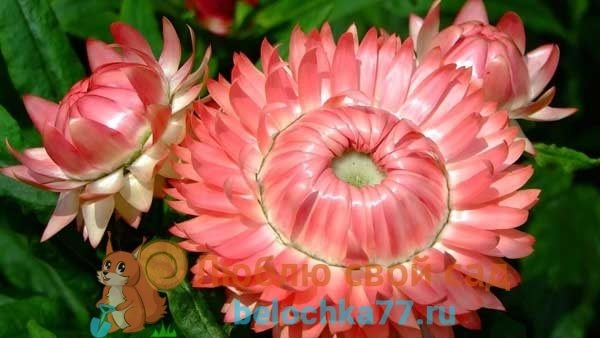

Variety Lotus
An upright bush 75-80 centimeters high. The buds shimmer with shades of pink, purple and cream. Abundant flowering, before cold weather. The variety is suitable for planting in flower beds, rock gardens, suitable for cutting.
Silvery rose
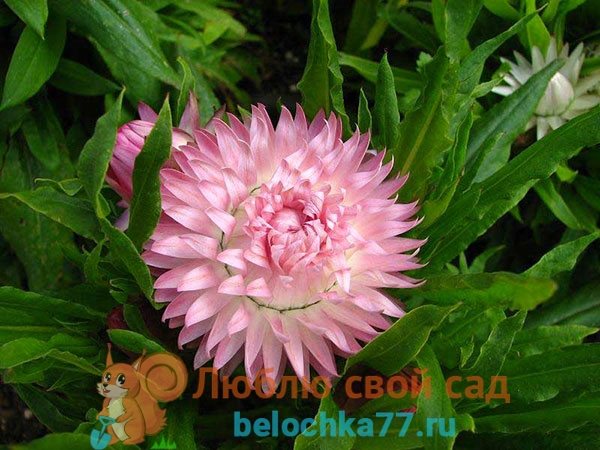

Variety Silver rose
Height - 70-90 centimeters. The flowers are large. The color of the inflorescences is pearlescent, white-pink. Flowers look very beautiful on any type of flower bed and in bouquets.
White
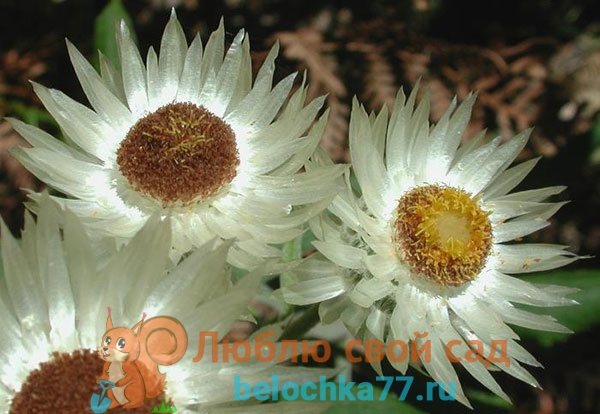

Variety White
The bush is 110 centimeters high. Flowering period July - September. The inflorescence is 6.5 centimeters in diameter. Scales of the envelope are filmy, white.
Royal robe
The flowers are medium, pink, coral or beige. Leaves are light green, lanceolate. Bloom July - October. Often grown for cut flowers.
Violet
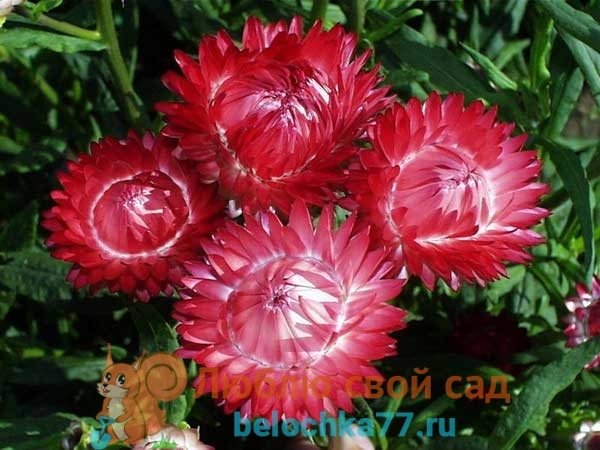

Violet variety
The bush is 110 centimeters high. Flowering period July - September. Inflorescence with a diameter of 4-6 centimeters. The scales of the envelope are violet-red.
Safari
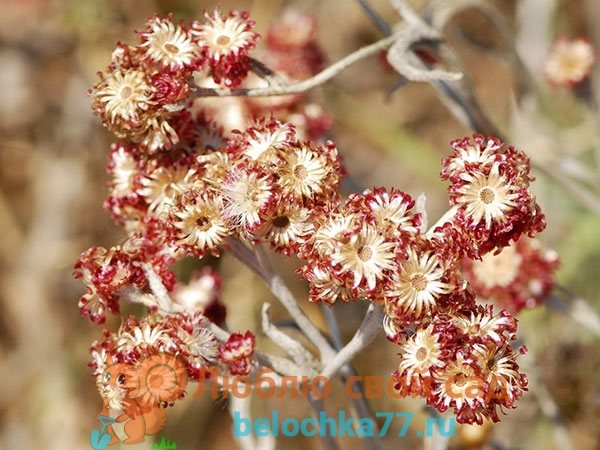

Safari variety
The plant is tall, reaching 1 meter. The inflorescences are colored in shades of salmon, salmon red and salmon pink.
Yellow
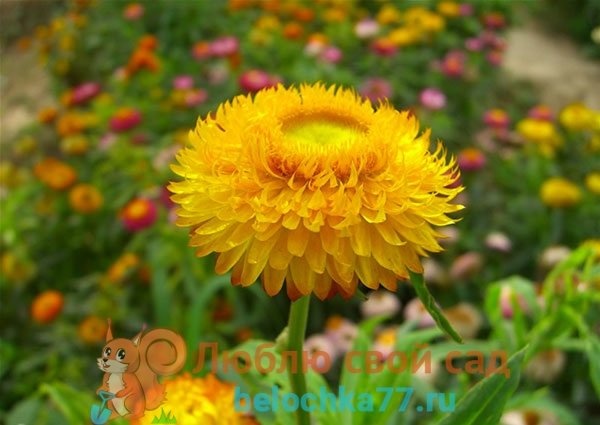

Yellow variety
The bush is 105 centimeters high. Flowering lasts from June 20 to early September. The inflorescences are 6 centimeters in diameter. Scales of the envelope are golden-yellow, filmy.
Moresca
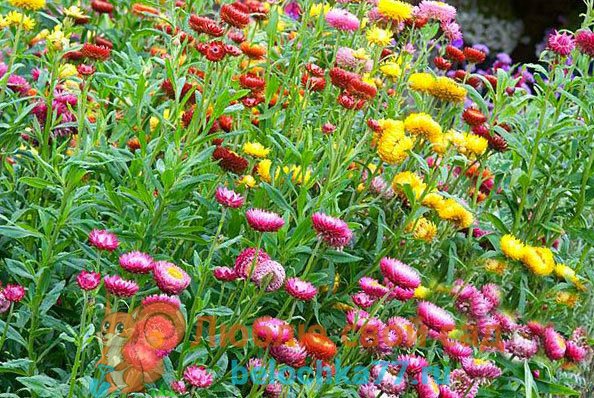

Moreska variety
The bush is 35-45 centimeters high. Terry inflorescences. The diameter is 3 centimeters. The color of the flowers is varied, in pastel colors.
Hot Bikini
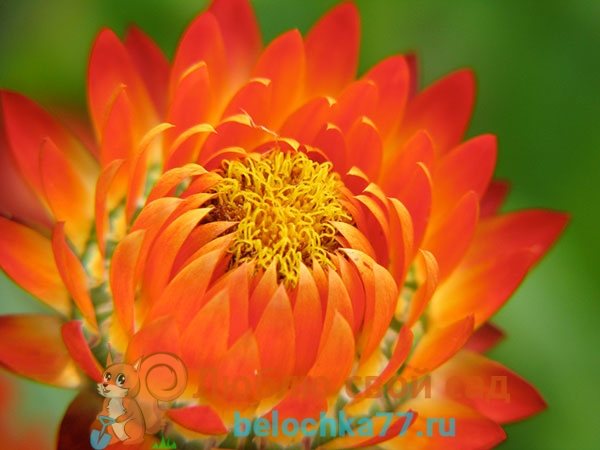

Hot Bikini Variety
The bush is low, 30 centimeters high. The inflorescences are about 2 centimeters in diameter. The color is bright scarlet. Bloom lasts from July to September.
Cuttings of Tsmin
Perennial helihrizums reproduce by dividing the bush or by cuttings. Cuttings preparation begins in August-September. To do this, take the upper part of the shoots. The length of the handle must be at least 15 cm.
In order for the cuttings to take root faster, they are dipped in Kornevin's solution before planting. Then they are planted in containers where there is a mixture of peat, soil and sand in a ratio of 1: 1: 2. The cuttings are covered with foil. After fresh leaves appear, the plant can be transplanted to a permanent place.
Photos of perennial gelichrizum can be viewed in periodicals, on the Internet or in this article.
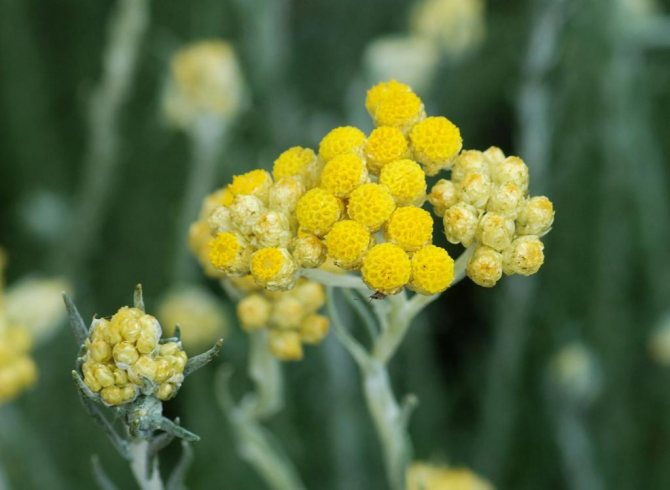

Planting sunflower in open ground
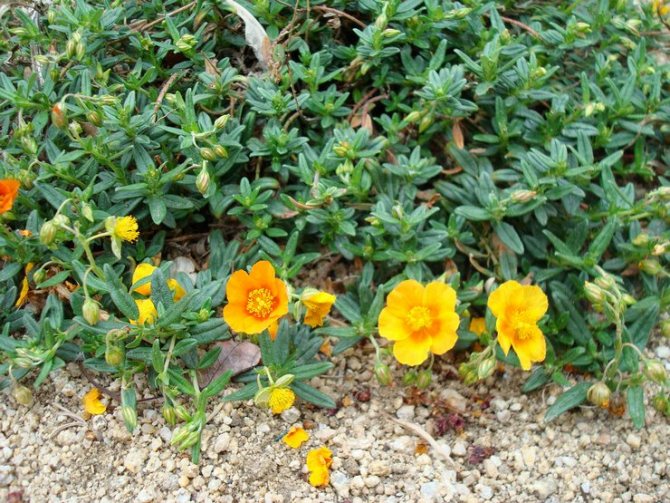

When is it better to plant sunflower
Planting a sunflower and further caring for them does not take much time and effort. Every flower lover can handle this, even without many years of experience in floriculture.
Seasoned seedlings can be transferred to an open flower garden or garden in the second half of May or the first half of June. Important conditions are well-warmed land and stable warm weather.
The planting site should be sunny and open, and the soil on the site should be alkaline or neutral in composition. The obligatory components of the soil should be fine gravel and coarse river sand. If there is loamy soil on the site during preparatory digging, it is recommended to add dolomite flour into it.
How to plant correctly
When preparing the landing holes, it should be borne in mind that the sunflower grows very quickly. The spacing between plants should not be less than 30-35 cm.The depth of the hole and the height of the plant pot should be approximately the same. A peat pot is placed in a hole, sprinkled with earth, watered.
Growing a plant
Stories about planting and leaving with a photo of gelichrizum can be found in the works of famous flower growers. Tsmin is a light-loving and heat-loving plant. Therefore, the site for its planting should be well lit. The plant prefers sandy and stony soils. Landing is carried out in pre-prepared holes. A drainage layer (small pebbles, expanded clay) is poured onto their bottom. Then fertilizers are applied. After that, plants are planted at a distance of 15-20 cm from each other.
A plant planted directly in open ground will bloom not earlier than August. And a flower grown in seedlings will release inflorescences in June. Tsmin blooms until the first frost.
Flower care is quite simple. However, it requires compliance with some subtleties. To get lush bushes of the plant, in tall varieties, the shoot is pinched over the 6th leaf.
To obtain healthy and beautiful buds, as in the photo of gelichrizum below, a special fertilizer or compost is applied under the plant. The first feeding is carried out during planting, and the subsequent ones - once every two weeks.
The plant should not be flooded. Increased watering should only be done on dry days.


Fertilizer gelichrizum
The annual cmin does not need frequent feeding, since fertilizers are applied when planting in the ground. In order for the plant to bloom until mid-autumn, it should be fertilized at the end of August with compost or fertilizer for flowering plants.
Perennial plants should be fed more frequently. The first feeding is carried out in the spring, then several times in the summer and once in the fall. As fertilizer, you can use compost or universal top dressing. Throughout the entire flowering period, the land around the bushes must be loosened and weeded.
Using gelichrizum in dry bouquets
In bouquets of dried flowers, according to the photo, gelichrizum takes the main place. These compositions keep people warm on cold and long winter evenings. To create such a bouquet, flowers with unblown buds are used. Then they are hung upside down with their heads in a well-ventilated area. There they will bloom to the required decorative state.
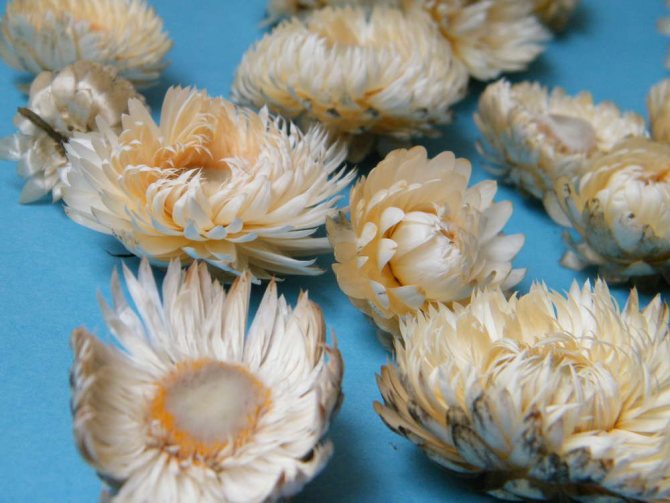

They begin to cut shoots for winter bouquets in July-August. You can dry the cmin either one by one, or several pieces. Depending on the color, they can be immediately assembled into bouquets. In this case, you need to tie in two places. If the immortelle is included in compositions of different flowers, then each shoot with a bud should be dried separately.
Gelichrizum, the photo of which is presented in the article, has bright and lively shades, which is confirmed in reality. It will perfectly decorate any flower garden, tub, hanging pot or basket. This plant will become a flower bed decoration, as well as create a good atmosphere in the house in the form of a fresh or dried bouquet.
Application in decor
The most beautiful and charming appearance of Gelichrizum with rich leaves and bright inflorescences will not leave anyone indifferent. It is used in mixed flower beds located near buildings or fences. It is great for decorating alpine slides and rocky garden areas. Inflorescences are actively used in floristic art. Tsmin is in demand when creating wreaths, garlands and bouquets, especially in winter.
Inflorescences that have blossomed incompletely are cut off in the autumn season. Leaves are removed as unnecessary. Cut flowers must be dried vertically, with their head down. Concerns about keeping dried flowers in the house are not justified, so you can safely admire the tsmin even after it has dried up. Zheltyanka is considered the guardian of youth and attractiveness. It is believed that it protects sleep, helps in eliminating poor health, and teaches cheerfulness.
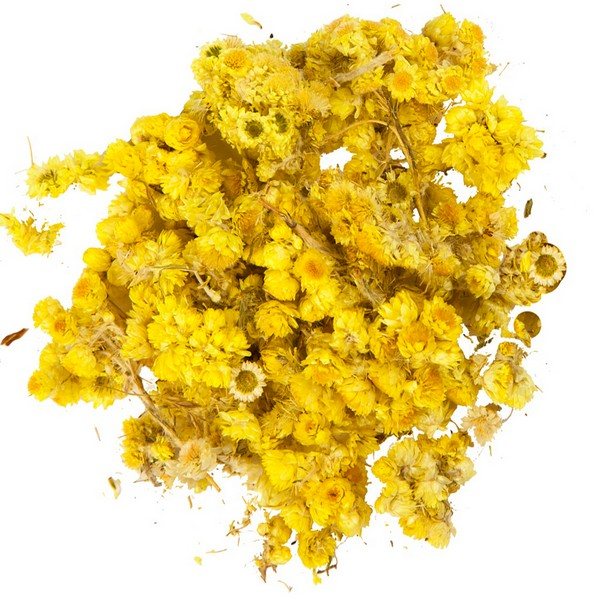

Such a flower is often dried.
Care
Watering
The plant is hygrophilous. In hot summer it is watered often and abundantly - 2-3 times a week. In the rainy season, natural precipitation is sufficient for the immortelle. Water it early in the morning or evening to reduce evaporation and allow the water to absorb. After the top layer has dried, the ground around the bushes is loosened. You can reduce the frequency of watering by mulching. Rotten sawdust and compost are suitable for this.
Top dressing
Although the plant loves nutritious soils, you should not get carried away with fertilizing. Otherwise, you will have to admire the bushes with excellent foliage, but without beautiful flowers.
Gelikhrizum is fed every 2 weeks with a full complex fertilizer. Before fertilizing, the plants are watered.
Transfer
The immortelle tolerates transplantation well. In one place, perennial gelichrizum can grow for 4-5 years, later the bushes grow, lose their decorative effect and need rejuvenation. Most often, the transplant is combined with the spring division of the bushes. It is better to replant plants in dry weather, the air temperature should not be lower than 10-12 ° C. So the plant will quickly take root in a new place.
How to keep a plant in winter?
Annual gelichrizums are removed from the flower garden in late autumn after the green shoots die off.
Perennial bushes are prepared for wintering. With the onset of autumn, watering is stopped. The bushes are cut, leaving a stump of 10 cm, and mulch abundantly with a thick layer of rotted sawdust or dry leaves to protect against low winter temperatures.
With container growing of perennial plants that do not tolerate cold weather, the mother liquors are brought into the room. This is done in the fall before the onset of frost. Shoots are heavily pruned, they can be used for further cuttings.
The optimum air temperature during winter maintenance should be in the range of 14-16 ° C. In winter, the immortelle is watered 1-2 times a week.
How to cut and preserve flowers correctly?
In order for the gelichrizum to evenly form a bush and look beautiful when cut, in tall varieties, the main shoot is pinched over 5-6 leaves. Low-growing plants do not pinch.
For drying, the shoots are cut in autumn in dry and sunny weather. They choose those in which the inflorescences have not fully opened. Their inner petals still cover the center, and 3-4 extreme rows lag behind the bud. During drying, the inflorescence will open even more, and when dried it will look neat and beautiful.
The immortelle is dried in the shade, in places with good ventilation. The cut shoots are tied into small bunches and hung down with their heads, after removing the lower leaves. It may take 14-30 days for complete drying.
Store dried flowers in a cool dry place. In a city apartment, a glazed balcony or loggia is suitable for this. If the weather is damp and rainy outside, the dried flowers need to be inspected regularly - there is a risk of mold.
They can also be stored at room temperature. But in very dry air, shoots and inflorescences can dry out, begin to break and crumble.
Dried inflorescences retain the brightness of colors for a long time and are ideal for winter bouquets.
Wintering
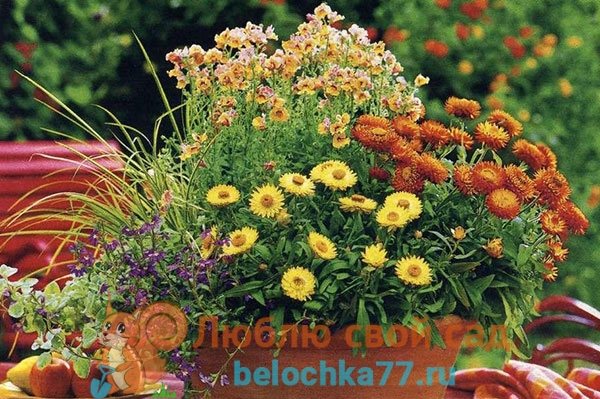

In regions with a cold climate, gelichrizum is most often grown as an annual. To preserve flowers, they can be transplanted into pots and placed on a heated balcony, loggia or greenhouse.
In regions with milder climates, flowers hibernate under a shelter of sawdust, pine needles, and dry foliage.
In the spring, after the snow cover disappears, the cover is removed from the flowers, after which the plants grow.
Gelichrizum characteristics and features
As a rule, in autumn all plants change their color, crumble and prepare for winter. Gelikhrizum is more durable during this period, it was even called the immortelle, since it can stand for a very long time after being cut, and when it dries, it also retains its properties for a very long time.The name of the flower "gelikhrizum" is translated from Greek as "golden sun." It was called that because it has terry buds with colorful bright sunny colors, incl. yellow, orange, red, etc.
In nature, there are about 600 varieties of this plant and they can be seen throughout Australia, Madagascar and in various European countries. The garden flower immortelle can be varied and have different flower diameters. Most varieties are undersized, but it is mainly on them that large flowers more than 2 cm in diameter appear. Gelikhrizum belongs to the Astrov family. Considered perennial, but sown like an annual. Resistant to extreme heat and does not require much moisture.
We suggest you familiarize yourself with: Decorations for giving ideas for creativity
The most important features of the Helichrizum (immortelle) are:
- Its stem is very strong and has a good branching structure.
- The roots are very developed and hold the plant securely.
- Lanceolate leaves are narrow, long and prickly, while having a rough surface with a silvery tint.
- Grown anywhere. There are varieties that creep up to 20 cm in height and erect up to 120 cm. The diameter of the inflorescence can be from 5 to 7 mm.
- Inflorescences have the shape of a panicle, which is densely covered with small flowers.
- Propagated by seeds; vegetative method is rarely used for planting.
- It blooms from mid-summer to mid-autumn, depending on the variety.
Possesses a wide variety of varieties. In nature, there are small dense bushes of immortelle with small flowers and tall bushes with a miniature or large flower, and all kinds of other types. Most of all, these types are widespread for cultivation:
- Sandy gelikhrizum is a garden perennial growing in our natural conditions. It looks like a bush with dense stems and leaves. Autumn is distinguished by a bright yellow flower that has an excellent scent. Observed in fields, forests, gardens, etc. It grows up to 15 cm high and blooms in the summer. Does not require special attention to care.
- Petiolate gelichrizum is an alpine plant that loves warmth very much. It needs regular watering and moderate feeding. Very popular with landscape design, as it is a creeping plant that weaves over a variety of surfaces. They can grow up to one meter. The leaves are oval in shape and, on the one hand, they are green, and on the other, with a silver tint. The inflorescences themselves are small in diameter. Among all gelichrisums for cultivation, it is considered very picky to care for.
- The bracts gelichrisum has a height of up to 75 cm. It has a branched shape. Inflorescences include various petals of all kinds of shades. Its flower is large (up to 6 cm in diameter) and double. The leaves are green and have a ribbed structure. He loves the action of ultraviolet rays very much, while it easily blooms in a semi-shaded place and does not require very frequent watering, but it is imperative to fertilize.
- Milford gelichrisum is very small in stature, therefore it resembles a carpet, which is densely covered with white and pink flowers on a gray-green background. Perfectly covers rocky areas. It can bloom throughout the summer season, and sometimes in early autumn.
Among the popular types of varieties of gelichrizum (immortelle) there are:
- Silver mist is used to beautify small hedges, outbuildings, and gazebos. It has long branches that twist well and can braid anything. They also hang beautifully from hanging flowerpots. Propagated by cuttings and seeds. They thrive better with good fertilization and regular watering.
- Lotus is a persistent garden shrub up to 80 cm in height. It has a very delicate color of buds, which beautifully shimmers with various shades of cream, pink and purple flowers. It blooms well until frost.Grows very well in fertilized soil in illuminated areas.
- Chico Red dwarf - an annual that has a small growth of up to 10 cm. Its leaves are dark green with a double effect and have bright red or burgundy inflorescences with a yellow middle. It begins to bloom in May and ends around September. Looks great in small pots and is suitable for planting near curbs.
- The Royal Robe is the most sought after variety. Designed for cutting and forming beautiful bouquets, both from live or dried flowers. Flowers are of medium size and different colors: pink, beige, scarlet, coral. Its leaves are light green. The color is thrown out from mid-June until the first frost. It requires fertilization and regular watering.
Features of the sunflower


Sunflower is a herb or shrub represented by annuals and perennials, the stem can be straight or creeping, its length varies from 0.1 to 0.3 meters. Opposite simple leaf plates can have a shape ranging from linear-lanceolate to oval. The racemose inflorescence consists of flowers, usually yellow in color, but they can also be pink, white or orange. The fruit is a one-or three-celled capsule with seeds inside.
Sowing a sunflower, or beauty by following the rules
Having purchased sunflower seeds in the company store, do not rush to sowing. You need to get down to business thoroughly, because a luxurious and unpretentious ground cover plant does not tolerate transplantation. Therefore, it is necessary to wait for warm May weather (at night - not lower than 14 ° C) and after that:
- choose a place. Shade or partial shade will not work, only a sunny area. Despite the unpretentiousness, the tender will be grateful for the nutritious soil, dry and loose, which will allow the plant to gain sufficient vegetative mass in the first years. Alternatively, a mixture of humus, peat, sand and compost. Stones, small crushed stone, gravel are welcome. And you end up with a solid green carpet;
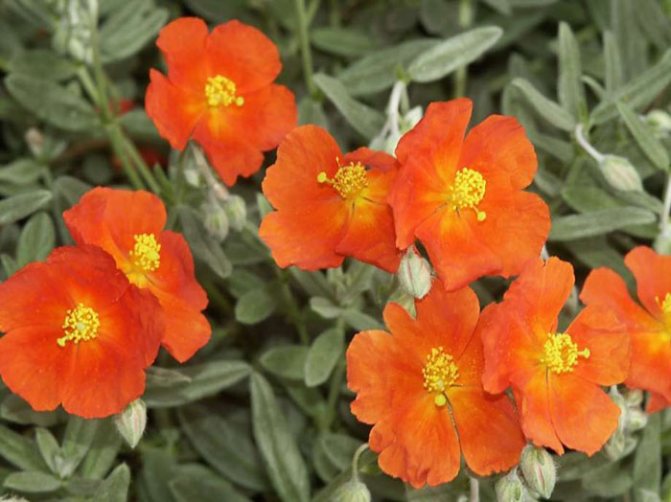

Sunflower needs shelter for the winter
- compact the soil in the place where the sunflower will be sown, shed the soil;
- sow seeds evenly (the best solution is preliminary mixing with sand), gently compact, cover with vermiculite or a thin layer of river sand, water.
After that, it remains only to wait for the shoots. In this case, you should be patient and attentive, because sunflower seeds are as lonely and unfriendly as verbena seeds: they sprout one at a time or in small groups with a difference of 14-21 days, that is, after the first shoots, you should wait and see the rest!
With friendly and uniform shoots, plants must be thinned out, removing weak, mechanically damaged or lagging behind in development. If later it turns out that there are not enough bushes, they can be propagated by layering. What is needed for this? Pin the longest part of the shoot to the ground in several places with pieces of wire or special plastic pins, water sparingly so that the cuttings take root. When the roots form, you will see a rosette, therefore, the plant can be separated from the mother bush.
Sunflower: general characteristics, or briefly about the main thing
As many have guessed, sunflower or tender is the popular name for heliantemum, a plant from the Ladannikov family. The flower received this name not by chance, but thanks to its peculiarity to open the buds with the sunrise, turn the flower heads after it and close them after the sun leaves the horizon. Just like a sunflower!
The homeland of the tender is the Mediterranean, North America. In the wild, heliantemum can represent not only a perennial ground cover (although the height of some species reaches 30 cm), but also a shrub.The plant itself pleases with neat, almost identical flowers, which are akin to purslane flowers - the same bright, delicate, consisting of 5-6 petals.
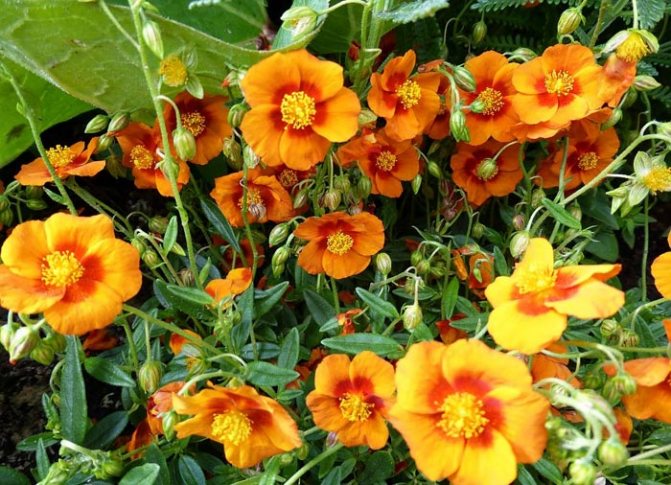

Sunflower is an unpretentious plant
However, wild species cannot boast of the variety of colors that the varieties bred by modern breeders have. Each grower can purchase a sunflower with buds of pink, snow-white, lilac, yellow and some other shades. It remains only to correctly propagate - and enjoy the dense carpet of greenery and bright flowers!
Sowing seedlings
As a rule, sowing sunflower seeds is carried out directly into open soil. However, there are times when it is recommended to grow it through seedlings, which are then transplanted into the garden. Sowing seeds for seedlings is carried out in the first days of March. To do this, it is recommended to use peat cups or tablets, the fact is that the root system of such a plant interacts with special beneficial fungi, and during transplantation or picking, this fungal layer can be destroyed, as a result, the planted bushes can get sick and even die. In this regard, experts do not advise that such a plant be subjected to picking, transplanting, and even reproduction by dividing the bush.
2 or 3 seeds are sown in one container, while they are laid out on the surface of a loose and moistened substrate, they are covered with a thin layer of sand or vermiculite on top, and the containers are covered with glass or film and transferred to a place where there is bright but diffused light, and the air temperature is kept within the range from 18 to 24 degrees. The first seedlings can appear in both 7 and 30 days. Immediately after this happens, the shelter is removed from the container, while the plants themselves are transferred to a cooler place (from 15 to 16 degrees). To improve the development and growth of seedlings, she needs to ensure the difference between the air temperatures during the day and at night, it should be about 4-5 degrees. After the plants grow up, they must be thinned out, for this, take scissors and cut those seedlings that are the weakest at the level of the surface of the substrate in each container. As a result, only one of the most powerful and healthy seedlings should remain in each glass. It is very simple to care for the seedlings, they need to be watered in a timely manner and the surface of the substrate near the bushes is systematically carefully loosened.
Growing immortelle from seeds at home
Seed collection is carried out from dried inflorescences after winter or from pre-cut flowers that were stored indoors throughout the winter. The germination rate is high, especially those that are harvested independently. In the store, there is a high probability of acquiring old, diseased seeds. In nature, the plant gives up its seeds in spring, and they germinate only after a year.
How to sow Helichrizum immortelle, we look at the video:
When to plant immortelles?
start from late March to early April. The timing of planting to a permanent place depends on the region of growth, therefore, it is necessary to calculate the timing of sowing. Late planting dates will not give early flowering, and early ones will stretch the seedlings, the plant will take longer to take root in a new place.
- For planting, use a universal soil mixed with pitch and small pebbles.
- The immortelle does not tolerate waterlogged soil, especially stagnant water, the plant immediately dies. Therefore, it is important to initially provide a well-drained soil.
- Seedlings can be sown in a warm polycarbonate or glass greenhouse. By the time of transplanting, the plants will be sufficiently developed to withstand the weather changes.
- Sowing is not necessary, but if it does not work out, it will be possible to break through excess seedlings or transplant the plants into separate containers. A transplant is performed when 2-3 true leaves appear.
- Further, it is enough to keep the soil mixture moist, without flooding it with water.You can do this little by little every morning. But if the ground is damp, it is better to skip watering.
- With steady heat, at the end of May, seedlings of immortelle can be planted.
- Do not forget to harden before planting, at least a week, or better for two: take the plants outside, gradually increasing the time spent outdoors. So the seedlings will get used to atmospheric conditions and will not hurt after planting.
Watering is carried out as the land dries up. On windows on the south side, the temperature is always higher, so you need to moisturize a little more often. The heating season dries up the air; this is not desirable for seedlings. It is better to protect from direct warm flow. Standing tap water will do. The seedlings do not need feeding.
Diseases and pests
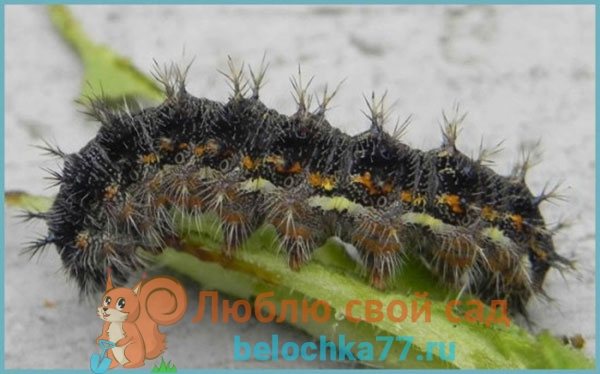

Among the diseases, gelichrizum is most often affected by white rust. Bordeaux liquid helps to fight this ailment.
The flower can also be affected by diseases such as wilting, downy mildew. At the first symptoms, it is necessary to remove the affected areas and treat the plants with fungicides.
The main pests of the flower are aphids and a burdock caterpillar. Insecticides are used to eliminate harmful insects.
Advantages and Disadvantages of Cultivation
The advantages and disadvantages of heliantemum are presented in the form of a table:
| pros | Minuses |
|
|

